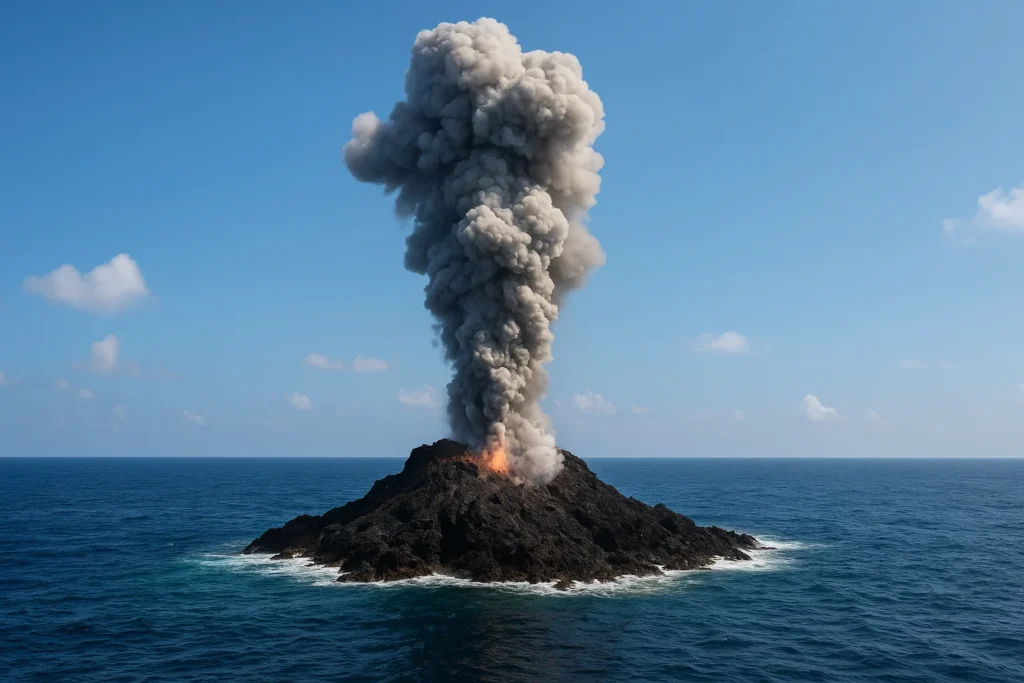Prologue: The Awakening of the Pacific Frontier
In the serene, deep-blue expanse of the Pacific Ocean, roughly 1,200 kilometers (750 miles) south of Tokyo, a monumental force lay dormant. This was the Ogasawara archipelago, a chain of remote islands often celebrated as Japan’s “Galapagos” due to its unparalleled biodiversity and unique ecosystems. Yet, beneath its peaceful surface, the very foundations of this island chain were born from fire and stone. On October 21, 2023, the stillness of the deep was shattered. Seismic sensors, like an early warning system for the planet’s pulse, began to detect a series of unusual tremors near the island of Iwoto, known historically to the world as Iwo Jima. This was the prelude to a spectacular geological drama, an event that would, for a fleeting time, redraw the map of Japan and offer humanity a rare, real-time glimpse into the planet’s creative heart.
Chapter 1: The Chronology of Creation
The Subtle Overture: A Crescendo of Earth’s Voice
The event did not begin with a roar, but with a whisper. Scientists with the Japan Meteorological Agency (JMA) first noted subtle shifts in the marine environment. Between October 15 and 20, 2023, their highly sensitive buoys began to register slight but persistent changes in sea temperature. This was followed by reports from local fishermen who noticed an unusual concentration of dead fish floating on the surface—a telltale sign of altered water chemistry and rising temperatures from a subsurface heat source. By October 20, the whispers had become a distinct rumble. A network of underwater microphones, known as hydrophones, picked up low-frequency harmonic tremors, a signature sound of magma on the move beneath the seabed. The stage was set for a powerful spectacle.
The Eruption Begins: A Violent Dawn
The climax of this initial phase occurred at 03:47 local time on October 21. The unnamed submarine volcano, a feature geologists provisionally designated “NT3-1,” erupted with astonishing violence. The ocean surface directly above the vent began to boil and churn, a cauldron of superheated water and volcanic gas. The Japan Coast Guard dispatched helicopters to the scene, and their pilots bore witness to a sight of primordial chaos. Towering columns of steam, ash, and smoke, known as “plumes,” shot 800 meters (2,625 feet) into the dawn sky, momentarily obscuring the sun. The sea around the eruption site turned a vibrant, milky turquoise as dissolved minerals from the magma were released into the water. This was an explosive phreatomagmatic eruption, a powerful interaction between searing magma and cold seawater. The blasts were so intense they hurled volcanic bombs—some of which were massive, exceeding 2 meters (6.6 feet) in diameter—high into the air.
The Island Emerges: A Satellite’s View
The birth of the island was a slow, deliberate process, meticulously documented by a flotilla of earth-observing satellites. These orbital eyes provided an unprecedented view of the land-building in action. On Day 1 of this emergence phase, a dark shadow, the nascent island’s summit, was observed sitting 12 meters below the surface. Over the next few days, a steady accumulation of volcanic material pushed the structure upward. By Day 3, the tip of the volcano broke through the water’s surface for the first time during low tide. Finally, on Day 5, a permanent landmass was confirmed, a new island standing resiliently above the waves, measuring an impressive 112m by 87m at high tide. The tiny island was now a part of the world, a new point on the map, and a subject of intense scientific fascination.
Chapter 2: The Science Behind the Spectacle
A Tectonic Triple Junction: The Engine Room of the Deep
The very existence of this island, and indeed the entire Japanese archipelago, is a direct result of a complex and violent geological setting. The new island sits at a particularly active point: the intersection of three colossal tectonic plates. To the east, the Pacific Plate is slowly but relentlessly subducting, or sliding, beneath the Philippine Sea Plate at a rate of approximately 8 cm per year. In this same region, a smaller fragment known as the Okinawa Plate also plays a role. This “triple junction” creates immense pressure and heat, melting rock deep within the Earth’s mantle and creating the magma that fuels the region’s numerous volcanoes. Chemical analysis of the erupted material revealed a fascinating mix of magma types: 60% tholeiitic basalt, a common type of magma found at mid-ocean ridges; 25% basaltic andesite, a slightly more silica-rich material; and a surprising 15% of unusual melts from the deep oceanic crust itself, offering a rare glimpse into the complex alchemy of the mantle.
The Mechanics of the Eruption: A Series of Violent Phases
The phreatomagmatic eruptions that formed the island were not a single event but a series of distinct phases, each with its own unique dynamics. The initial Magma-Water Interaction Phase (October 21-25) was characterized by near-constant steam explosions occurring every 4-7 minutes. These blasts propelled ash plumes as high as 5,000 meters into the atmosphere. This gave way to the Fragmentation Phase (October 26-30), where the eruptions became a continuous, high-pressure jet of debris. Observers described a “rooster tail” effect as a continuous stream of material was ejected from a rapidly forming crater, which grew to a diameter of 40 meters. Finally, the Emergence Phase (October 31-November 5) saw the relentless accumulation of volcanic debris. The volcano was building its own land, with material accumulating at an astonishing rate of 2,000 tons per hour, a tangible sign of Earth’s power to create land in real-time.
Chapter 3: Parallels in History and the Islands That Survived
A History of Transient Lands in Japan
The story of Japan’s newest island is part of a longer, historical narrative of creation and destruction. The country has a rich history of such formations, many of which have since vanished beneath the waves. An island that formed near the Izu Islands in 1904 lasted a mere 8 months before being completely eroded. Another island that appeared near Sakurajima in 1914 was more fortunate, lasting 2 years before it eventually merged with the mainland. Perhaps the most famous and cautionary tale is that of an island near Fukutoku-Okanoba in 1986, which lasted only 3 months before it was submerged. However, the precedent for success is the island of Nishinoshima, which began forming in 2013. Through sustained eruptions and lava flows, it has grown from a tiny islet into a substantial, permanent landmass, a testament to the power of a resilient, lava-based foundation.
Global Analogues: Lessons from Around the World
The phenomenon is not unique to Japan. All over the world, from the icy waters of the Arctic to the warm seas of the South Pacific, similar events have occurred. In 1963, a volcanic eruption off the coast of Iceland gave birth to Surtsey, which has since become a UNESCO World Heritage site and a living laboratory for studying how life colonizes new land. The Hunga Tonga eruption of 2015 created an island in Tonga that has also survived. Even the Zubair Group in Yemen saw the formation of an island in 2011 that lasted for 6 years. Each of these stories offers a unique data point in the scientific puzzle of island formation and longevity, providing a rich context for understanding the future of Japan’s newest landmass.
Chapter 4: The Race Against Time – Scientific Missions and Insights
The First Survey: Gathering Data in a Volcanic Crucible
The moment the island became stable enough, a joint team from the JMA and the University of Tokyo launched a mission to conduct the first comprehensive on-site study on November 7, 2023. This was a hazardous but crucial undertaking. Using advanced laser-scanning technology, they created a detailed topographical map of the island at a remarkable 5cm resolution. Gas emissions were measured, revealing a daily output of 1,200 tons of sulfur dioxide (SO₂), a key indicator of ongoing volcanic activity. The surface temperatures were extreme, reaching 98°C (208°F) on the surface, while internal temperatures exceeded 300°C (572°F), a searing heat that spoke to the immense thermal energy still contained within the volcano.
A Continuous Watch: Monitoring a Living Island
The monitoring of the island has since become a continuous, multi-pronged effort. Daily drone overflights capture high-resolution imagery, allowing scientists to track changes in the coastline and erosion rates in real-time. Weekly bathymetric surveys by autonomous underwater vehicles map the seabed around the island, measuring its underwater growth and any signs of instability. A real-time seismometer array has been installed to listen for the slightest tremors, providing an early warning system for any changes in the volcano’s behavior. These efforts are not just about watching a spectacle; they are about collecting invaluable, first-hand data on the forces that have shaped our world for billions of years.
Chapter 5: The Human Dimension – Navigating a New Reality
Implications and Opportunities
The birth of a new island, however small, has a range of implications that extend beyond pure science. Economically, it could create new fishing grounds as volcanic reefs attract marine life, and there’s the possibility of valuable mineral deposits beneath the surface. Politically, the emergence of new land in the ocean raises questions about territorial boundaries and Exclusive Economic Zones (EEZs), with international maritime law needing to be applied to this unexpected addition to the map. Culturally, the island’s name and its potential role in Shinto traditions have already sparked discussions, a testament to the deep connection the Japanese people have with their land and its natural forces.
The Future: Three Possible Scenarios
The fate of the island remains a compelling open question. Scientists have outlined three potential scenarios for its future:
- Ephemeral Existence (60% Probability): The most likely outcome is a short life. Erosion will begin swiftly, and without a hardened lava core, the island could be completely gone by June 2024, leaving behind only a shallow, submerged reef.
- Semi-Permanent (30% Probability): A more optimistic scenario predicts that lava flows could begin within the next few months, giving the island a more resilient foundation. It could last anywhere from 5 to 15 years before eventually succumbing to the natural process of geological subsidence, where the weight of the island itself causes it to slowly sink.
- Permanent Addition (10% Probability): The least likely but most exciting scenario is a long and enduring life. This would require sustained volcanic eruptions for more than 3 years, allowing a substantial lava shield to form. If this occurs, the island would become a permanent part of Japan’s official maps by 2030.
Epilogue: Lessons from a Fleeting Land
The story of this nameless island is a profound metaphor for humanity’s relationship with our dynamic planet. In an era when we believe we have mapped, measured, and understood every inch of the globe, Earth still reserves the capacity to surprise us, to remind us of the primal forces that shaped the world. Whether this particular island endures as a new landmark or vanishes back into the sea, its brief existence has already contributed invaluable data to our understanding of submarine volcanism, rapid landform evolution, and coastal erosion dynamics. As Dr. Hiroko Fujimoto of the Japan Coast Guard so eloquently stated, “We are not just witnessing geology—we are seeing poetry written in fire and water, a verse that may be brief but will echo through scientific literature for decades.” This island’s story, a reminder that our planet is a living, breathing entity, is still being written, one eruption and one wave at a time.



